Effective Strategies for Booking Meeting Spaces

Introduction
In today’s dynamic work environment, meeting scheduling tools have become indispensable, helping to streamline the process of setting up gatherings and reducing the hassle of back-and-forth communications. These tools are crucial for enhancing productivity, especially when considering that professionals still spend a significant portion of their time in meetings. By addressing common issues like overlapping schedules and last-minute changes, scheduling tools ensure that meetings are more efficient and less disruptive.
Moreover, with the rise of remote work leading to an increase in the number of meetings, it is more important than ever to manage these effectively. Research has shown that well-implemented scheduling tools not only help in optimizing meeting times but also improve focus and goal alignment within organizations. This article delves into the significance of meeting scheduling systems, key features to look for, best practices for managing meeting room reservations, and solutions to common challenges in meeting space management.
Understanding the Importance of Meeting Scheduling Tools
Meeting scheduling tools are essential in today’s fast-paced work environment, ensuring everyone is on the same page when setting up gatherings. They simplify locating appropriate moments for participants, minimizing the back-and-forth communication that frequently results in confusion. As per a trends report, professionals utilize an average of 14.8 hours weekly in discussions, reduced from 21.5 hours in 2021, yet 37% of their time is still occupied by discussions. This emphasizes the significance of efficient scheduling resources to boost productivity.
These resources also tackle frequent problems such as conflicting schedules and sudden alterations, which affect nearly half of all gatherings. A survey of over 1,300 professionals revealed that remote work has increased the number of gatherings, with 61% of workers participating in more discussions due to the shift. By utilizing scheduling resources, organizations can handle these increases more effectively.
“Christina Janzer, Slack’s Senior Vice President of Research and Analytics, emphasized, “Gatherings are often at the root of a lot of problems, so it feels like such a critical issue to resolve.” This sentiment is echoed by a study at Atlassian, where limiting gatherings to no more than 30% of the week and blocking periods for focused work resulted in a 32% improvement in focus and 31% more progress on top priorities.”.
Integrating these resources not only enhances gathering durations but also fosters improved objective alignment and purposefulness, as emphasized in studies by Ava Elizabeth Scott and associates. They discovered that clear objectives significantly boost productivity and diminish the sense of wasted effort.
In general, utilizing appointment coordination tools can result in a more effective use of hours, guaranteeing gatherings occur at suitable moments for everyone involved, and ultimately fostering operational excellence.

Key Elements of an Effective Meeting Scheduling System
An effective meeting arrangement system should encompass several essential features to optimize the appointment management process. A user-friendly interface is crucial, allowing users to easily navigate and select available time slots. Calendar integration is another crucial component, ensuring seamless synchronization with existing calendars, thereby preventing double bookings and conflicts in planning.
Adjustable preferences allow individuals to customize the planner to their particular requirements, facilitating personalized setups that improve overall effectiveness. Automated reminders play a significant role in keeping all participants informed and reducing the likelihood of missed appointments.
Systems like ScheduleJS have demonstrated the importance of a visually appealing and functional interface, providing users with the ability to manage their schedules effortlessly across various devices. This flexible design ensures a consistent and efficient user experience, which has been met with positive feedback for improving daily operations.
For smaller groups or those pursuing non-commercial solutions, platforms like Rallly. Co provide a straightforward yet efficient approach for organizing gatherings. By allowing self-hosting options, these tools provide an alternative to more complex systems like Exchange or O365, making them an ideal choice for smaller setups.
Overall, the incorporation of these essential attributes in scheduling systems aids in simplifying the procedure, facilitating the booking of slots, reserving areas, and ensuring everyone is informed about forthcoming gatherings.
Best Practices for Managing Meeting Room Reservations
Overseeing room reservations is more than merely reserving a space; it demands a strategic approach to guarantee seamless operations. Creating explicit rules, including deadlines, cancellation procedures, and priority usage regulations, is essential. For example, utilizing resources such as the Tap Scheduler can greatly simplify the procedure by offering a user-friendly interface that assists in avoiding room conflicts and allows for straightforward scheduling modifications if gatherings conclude early or need additional time.
Incorporating advanced features like touchscreen consoles and voice commands through solutions like Microsoft Teams Rooms can further enhance the efficiency of management. These resources not only streamline the booking process but also enable effortless content sharing and management of audio and video settings.
In the context of evolving business needs, smaller gatherings are becoming more popular, with 40% of events in the U.S. hosting 75 people or fewer. This shift emphasizes the significance of having adaptable and effective planning tools that can accommodate both large and small gatherings.
Furthermore, cultural factors can also influence the arrangement of appointments. For example, in nations like Germany and Japan, punctuality is highly valued, whereas in Saudi Arabia, gatherings are often arranged around prayer times. Grasping these nuances can assist in developing a more inclusive and respectful planning system.
By applying these best practices and utilizing advanced scheduling tools, organizations can reduce conflicts and ensure that their resource allocations are used effectively, ultimately leading to improved collaboration and productivity.

Common Challenges in Meeting Space Management and Their Solutions
Managing meeting spaces can be quite a challenge, with common issues like double bookings, underutilized rooms, and last-minute cancellations. To tackle these effectively, leveraging analytics to understand usage patterns can be incredibly beneficial. Analytics can provide insights into peak usage times and identify which spaces are frequently booked or overlooked. Armed with this data, organizations can adjust their policies to maximize efficiency.
Additionally, fostering a culture of open communication is essential. Motivating team members to communicate their availability requirements and possible issues can assist in reducing misunderstandings and enhancing overall productivity. According to a survey conducted by Cvent and the Northstar Meetings Group, event planners are significantly happier with their venues and supplier partners when there’s clear communication and coordination. This open dialogue ensures that everyone’s needs are met and that spaces are used optimally, reducing the chances of conflicts and cancellations.
Moreover, integrating advanced technologies such as AI can further streamline the process. AI-powered tools can predict booking trends and suggest optimal scheduling, minimizing the risk of double bookings and underutilization. As pointed out by Sabrina Jackson, Senior Director of Product Management at Duetto, AI has the potential to revolutionize the hospitality sector by automating and enhancing different processes, including space management. This not only enhances efficiency but also provides a seamless experience for all users.
Incorporating these strategies can significantly improve the management of meeting spaces, ensuring that they are used effectively and efficiently, ultimately leading to better organizational performance.

Conclusion
Meeting scheduling tools have proven to be essential in navigating the complexities of modern work environments. By streamlining the process of setting up meetings, these tools significantly reduce the time spent on back-and-forth communication while also addressing common scheduling challenges. With professionals dedicating a considerable amount of time to meetings, the implementation of effective scheduling systems becomes crucial for enhancing productivity and ensuring alignment within teams.
Key features such as user-friendly interfaces, calendar integration, and automated reminders play a pivotal role in optimizing the scheduling experience. These elements not only make it easier to manage appointments but also facilitate smoother meeting room reservations. By adopting best practices and utilizing advanced technologies, organizations can create a more efficient meeting culture that accommodates both large and small gatherings.
Moreover, addressing common challenges in meeting space management through analytics and open communication can lead to better resource utilization. Embracing innovative solutions, including AI-driven tools, can further enhance efficiency and minimize conflicts. Ultimately, investing in meeting scheduling tools and practices can drive operational excellence, ensuring that meetings contribute positively to organizational goals rather than detracting from them.
